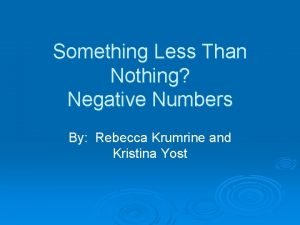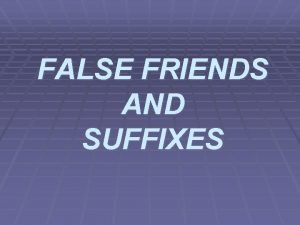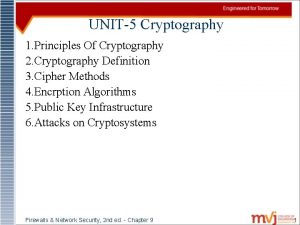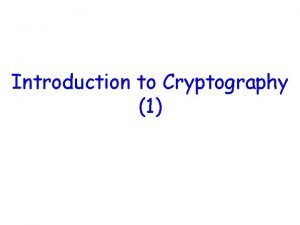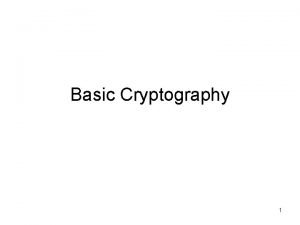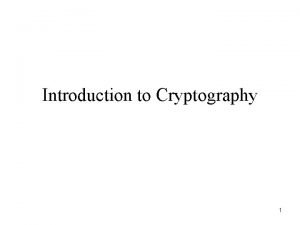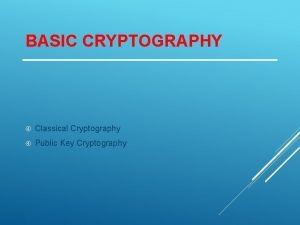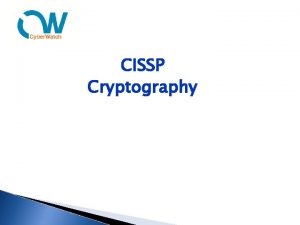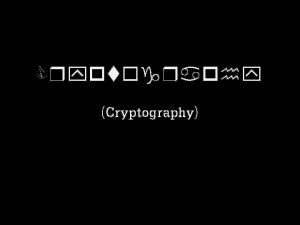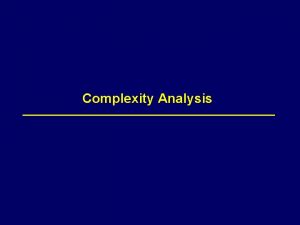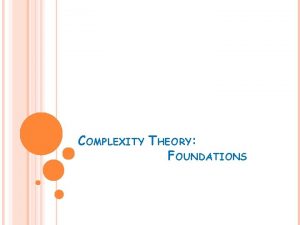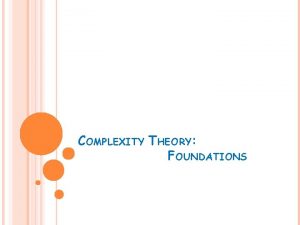Cryptography Where Complexity Finally Comes In Handy Complexity



























- Slides: 27

Cryptography Where Complexity Finally Comes In Handy… Complexity ©D. Moshk 1

The Amazing Adventures of Alice and Bob extremely secret message Alice Bob eavesdropper Complexity ©D. Moshk 2

PAP 279 -298 Introduction • Objectives: – To introduce the subject of cryptography and its tight connection to complexity • Overview: – Public key cryptography – One-Way Functions and Trapdoor functions – RSA Complexity ©D. Moshk 3

encoding key Intuitive Approach E(e, decoding key extremely secret message )D(d, Alice ) Bob eavesdropper Complexity ©D. Moshk 4

Simple Implementation: Just XOR! Problem! Agree first on some random string e. e extremely secret message e ( Alice ) Bob eavesdropper Complexity ©D. Moshk 5

Solution: Public-Key Cryptosystems • Bob generates a pair of keys • Publishes E • Keeps D private E(x) Bob D(y) Complexity ©D. Moshk 6

Encryption: Requirements • “Easy” (so everyone can send Bob encrypted messages) • “Hard to invert” (so no one can break the encryption) Complexity ©D. Moshk 7

SIP 375 One-Way Functions: Formally Definition: A length preserving function f is a oneway function if: some 1. f is computable in polynomial time. textbooks 2. f-1 cannot be computed in probabilistic demand f is one-to-one polynomial time, i. e Complexity ©D. Moshk 8

One-Way For sufficiently large natural n For any Turing Machine M For any natural constant k M inverts f correctly on at most n-k of the inputs Probability taken over: choices made by M random selection of w Complexity ©D. Moshk 9

Applications: Authentication • Many users may login to a network • Each user has a password • The database can be read by everyone • Problem: secure authentication Complexity ©D. Moshk 10

How to Authenticate Using OWF? One-Way Function • Encrypt each password with a OWF. • Store only the encrypted password. • When this user tries to login… – Encrypt the password she entered – Compare to the stored password Complexity ©D. Moshk My. Pass 1234 2 i. B>S]1%^o 11

Do One-Way Functions Exist? • Believed to… • OWF P≠NP. Complexity ©D. Moshk 12

Do One-Way Functions Suffice? Problem: How would Bob generate D(y)? D is so hard, I don’t know how to compute it myself… Bob Complexity ©D. Moshk 13

Trapdoor Functions probabilistic polynomial-time TM G family of functions which are hard to invert f 1 index f 2 f 3 … the key to invert that function Complexity ©D. Moshk 14

SIP 376 -377 Trapdoor Functions : Formally Definition: A length preserving indexing function f: * * * is a trapdoor function, if there exist f(i, w)=fi(w) <index, key> generator • a poly-time TM G • a function h: * * * which satisfy: decoder Complexity ©D. Moshk 15

SIP 376 -377 Trapdoor Functions : Formally 1. f and h are computable in polynomial time. 2. “fi is hard to invert in the absence of t” <i, t> is output by G 3. “fi is easy to invert when t is known” Complexity ©D. Moshk 16

RSA • A public-key cryptosystem developed by Rivest, Shamir and Adleman. • Based on the (conjectured) hardness of factoring. Complexity ©D. Moshk 17

Plan 1. Prime numbers: basic facts and recent results. 2. Euler’s function. 3. Description of the RSA cryptosystem. Complexity ©D. Moshk 18

PRIMES • Instance: A number in binary representation. • Problem: To decide if this number is prime. Complexity ©D. Moshk Yes instance: 10111 No instance: 10110 19

Is PRIMES in P ? ! What’s the problem with the following trivial algorithm? Input: a number N Output: is N prime? for i in 2. . N do for j in 2. . N do if i*j=N, return FALSE return TRUE Complexity ©D. Moshk 20

Prime Numbers • Fact 1: There are many prime numbers (k/log k in the range [k]={1, …, k}) • Fact 2: ([AKS 02]) Primality testing can be done in time polynomial in log k. • Question: How to choose a random prime in [k] in time poly-log k? Complexity ©D. Moshk 21

Picking a Random Prime • while didn’t-find-one uniformly at random – choose x R [k] – if x PRIMES [k] • return x Expected time: O(polylogk) Complexity ©D. Moshk primes 22

De-Randomization • By Alon et Al and Naor, there’s a deterministic construction X of O(logk/ 2) numbers in [k] which is -close to uniform. If Prx R[k] [x S] > X S≠ • By using it with < log-1 k, we can obtain O(polylogk) run-time (not just expectedly!) Complexity ©D. Moshk 23

Euler’s Function • (n) = { m | 1 m < n AND gcd(m, n)=1 } • Euler’s function: (n)=| (n)| Example: (12)={1, 2, 3, 4, 5, 6, 7, 8, 9, 10, 11} (12)=4 Observe: For any prime p, (p)={1, . . . , p-1} Complexity ©D. Moshk 24

RSA • To encrypt a message, write it as a number m, and compute EN, e(m) = me (mod N) • To decrypt a cipher text c, compute Dd(c) = cd (mod N) • Now for (almost) any m, – med m (mod N) – And therefore: (me)d m (mod N) Therefore: Dd(EN, e(m)) m Complexity ©D. Moshk (mod N) 25

The Public and Private Keys • Choose two long random prime numbers p, q – set N = pq • Randomly choose an odd number e s. t: – 1 < e < (N) Compute d using Euclid’s – gcd(e, (N)) = 1 • Let d be the inverse of e, namely gcd algorithm ed 1 (mod (n)) Public key: <N, e> Complexity ©D. Moshk ; Private key: d 26

Summary • We presented the notion of Public Key Cryptosystems and its well-known implementation, RSA. • We examined some of the underlying assumptions of cryptography: – Existence of one-way functions – Existence of trapdoor functions • These assumptions are stronger than the standard complexity assumption P≠NP. Complexity ©D. Moshk 27
 Time space complexity
Time space complexity First comes love then comes marriage
First comes love then comes marriage The nickname “handyman” is given to the species.
The nickname “handyman” is given to the species. Handy bitte
Handy bitte Organisatiecultuur/bedrijfscultuur meten
Organisatiecultuur/bedrijfscultuur meten Handy board microcontroller
Handy board microcontroller Funpot
Funpot Ist situatie
Ist situatie Handy surf
Handy surf Hatchet chapter 11 questions and answers
Hatchet chapter 11 questions and answers Irmaworks
Irmaworks Cultuurtypologie handy
Cultuurtypologie handy Handy dandy earth science reference tables
Handy dandy earth science reference tables Cultuurmodel handy
Cultuurmodel handy Handy wear
Handy wear Barry esposito
Barry esposito Grendel finally shows fear when
Grendel finally shows fear when She got the job because she
She got the job because she Estabraq muayad
Estabraq muayad Finally brethren farewell
Finally brethren farewell Tell-tale heart questions
Tell-tale heart questions Finally brothers whatever is true
Finally brothers whatever is true In his darkroom he is finally alone war photographer
In his darkroom he is finally alone war photographer Closing of the western frontier
Closing of the western frontier Cause and effect circle
Cause and effect circle In what century were negative integers finally accepted?
In what century were negative integers finally accepted? Finally my brethren
Finally my brethren Finally false friend
Finally false friend

























